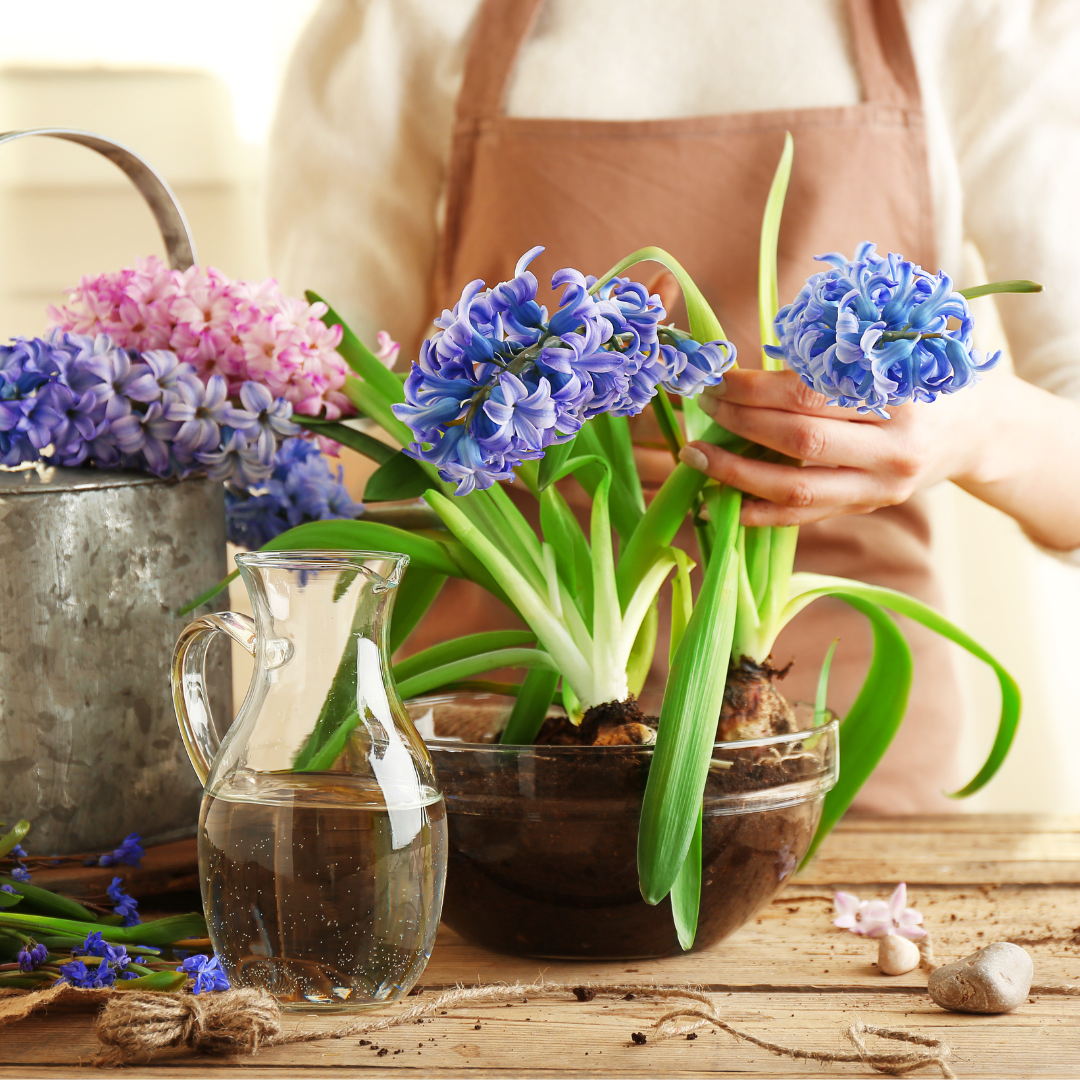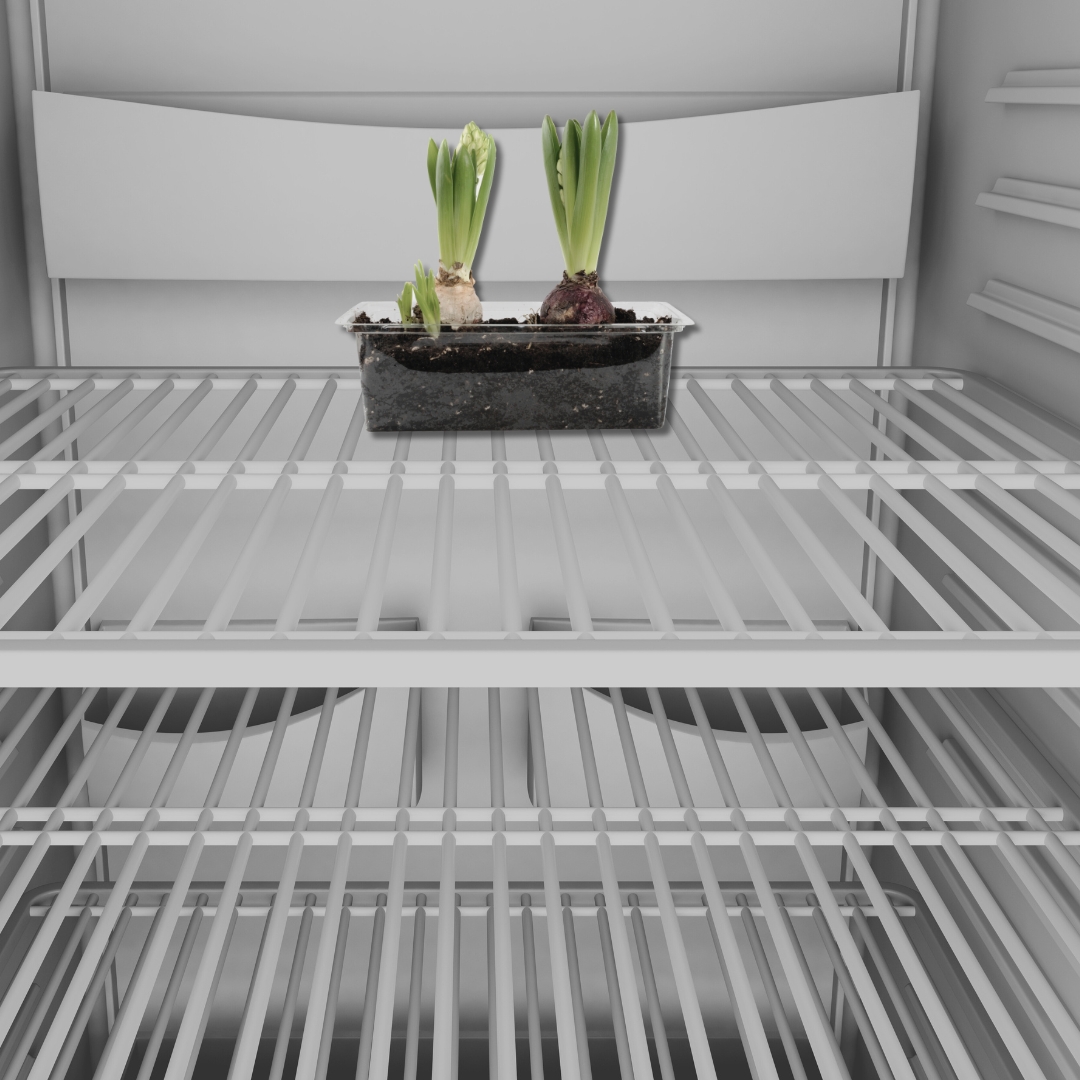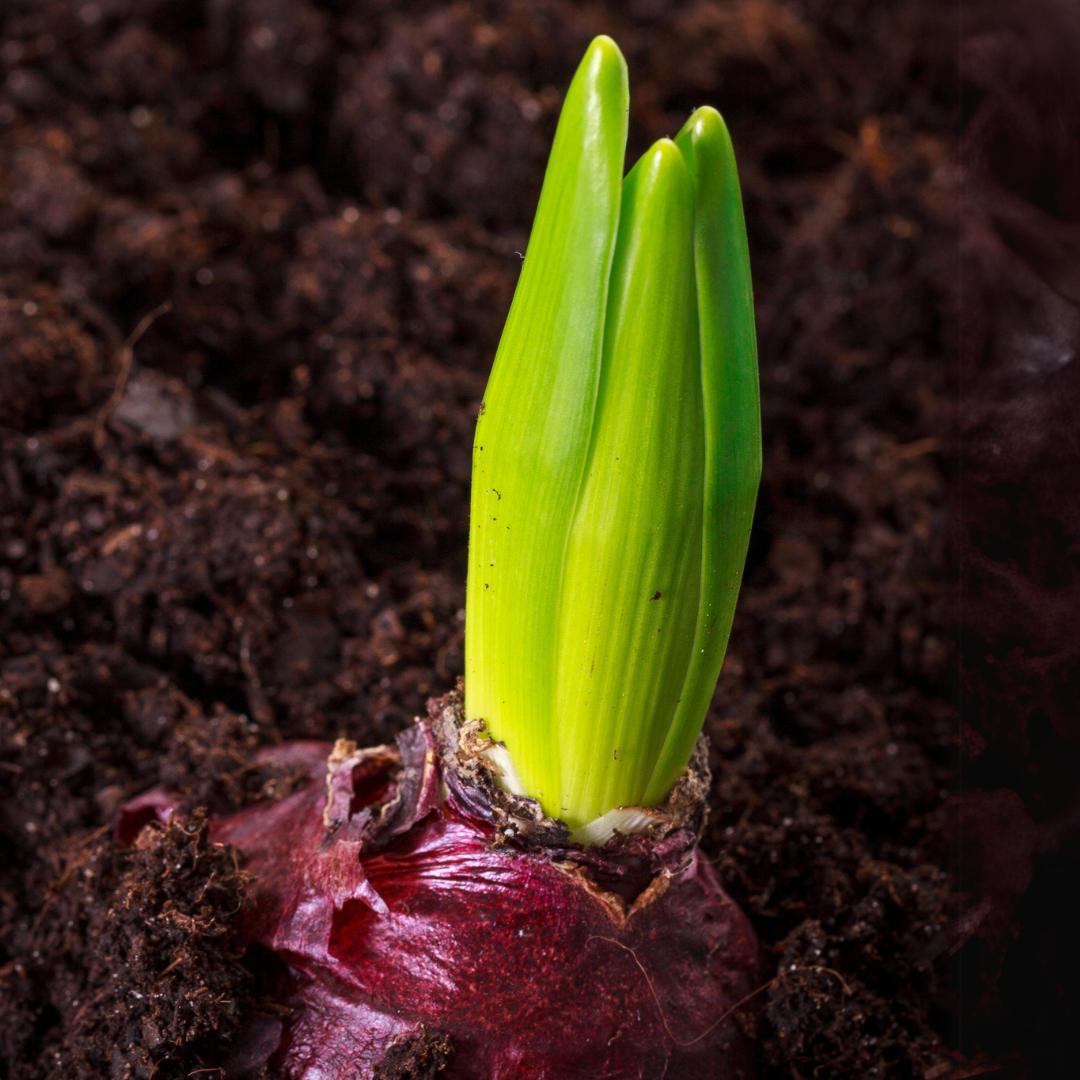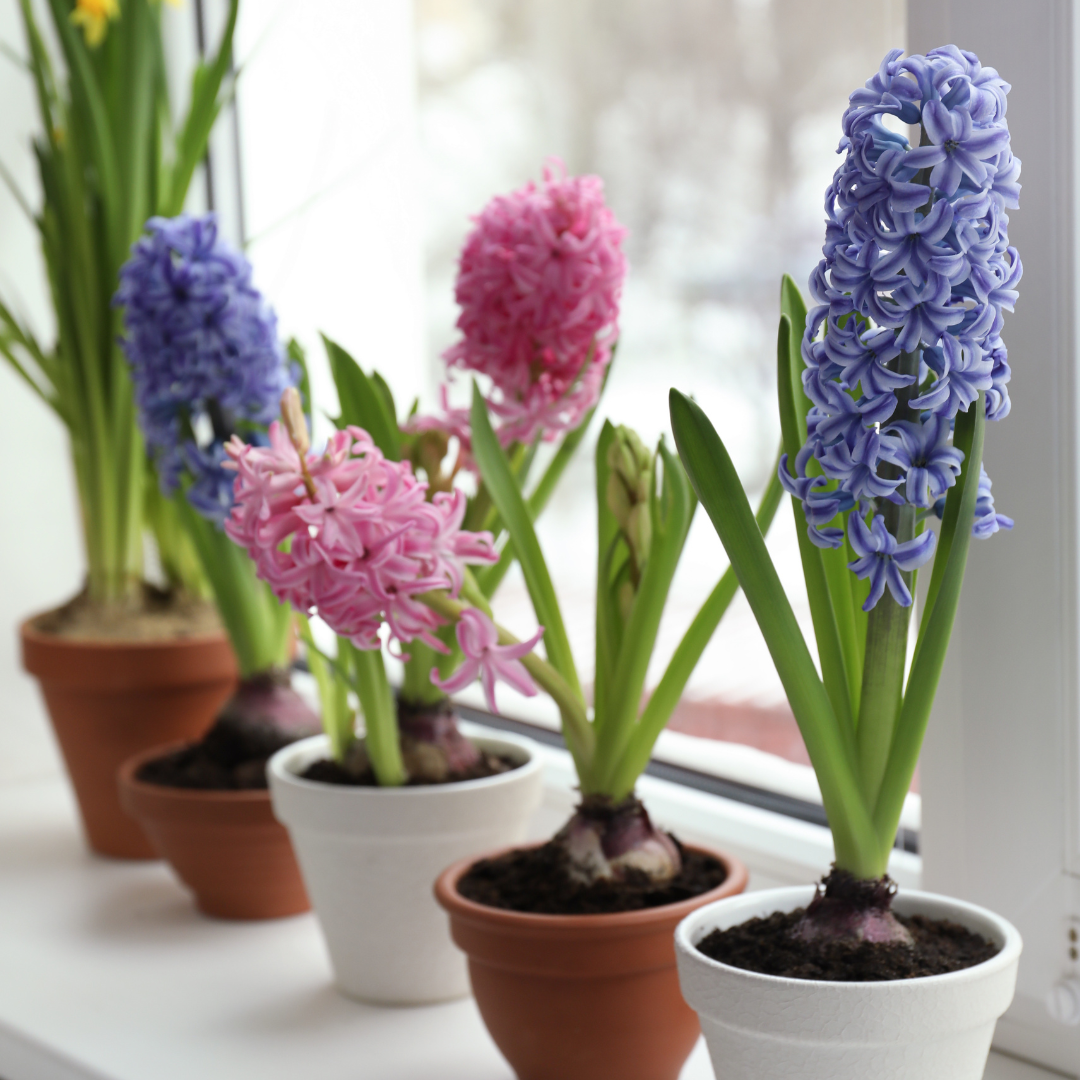Struggling to keep your hyacinths healthy and vibrant in a vase? Or maybe you’re wanting to have your own winter-blooming hyacinth bulbs like you’ve seen in your neighbor’s windowsill? You’re not alone! These bulbs have been showing off for many years, giving people fragrant blooms and color throughout the winter. Today I wanted to share with you how to care for your own hyacinth so you can also enjoy these beautiful blooms, no matter the time of year!
Here’s what we’re covering:
- How to force hyacinths indoors
- Indoor Hyacinth care
- How to properly preserve and store your hyacinth bulbs

How to Force Hyacinth Blooms Indoors
Ever wonder how flower stores manage to have beautiful cut hyacinths all throughout the year? It’s because they force them! Forcing bulbs means that you are causing the plant to bloom at a time when it doesn’t naturally bloom (any time other than early spring). The fun part about bulbs is that you can really force them to bloom at any time of the year with some proper planning! And here’s how!
Place Bulbs in Cold Storage
First, you need to understand that hyacinth are spring bulbs, meaning that they need a period of cold temperatures (aka winter!) to tell them when it’s time to flower again. To simulate this indoors, you need to move your bulb to a “cold storage”. The best place to do this is in a dry refrigerator. (I personally place my bulbs in a paper bag in the vegetable box of my fridge, just don’t place them near any fruits or vegetables…) They need to stay in this cold environment for about 12-16 weeks to mimic winter temperatures.

Note that if you are trying to force grape hyacinths (Muscari varieties), these are not true hyacinth bulbs. These techniques for forcing are similar, but they only need a minumum of 8 weeks for their chill period. This 12-16 week period is for dutch hyacinths.
Another quick tip, is that sometimes you can order bulbs in the winter that have already been chilled, or have been partially chilled. This means that sometimes you can buy them already sprouting (the nursery has already chilled them for 12-16 weeks), or you can get some that have been partially chilled, meaning that you only have to keep yours in a cool spot for 5-6 weeks instead. This can be very helpful!
Just be aware that if you are purchasing your bulbs in the summer time that they need to be either have their chill requirements already met, or you will need to do the complete 12-16 weeks of cold storage. This is because the warm temperatures during shipment can cause them to start to sprout! And without the proper cold storage, they might not be able to flower… (This is why most bulbs are sold in the winter or springtime!)
After this chill period has been met, then you can either place your hyacinth bulb in water (the most popular choice), or in soil. I will cover the instructions for each below.
Flowering Hyacinths in Water
After your chill period has ended, you can bring your bulb out of the cold and start the exciting part of the forcing process! The best way to force your hyacinth in water is to get a container that holds your bulb, but keeps it above and out of the water. They have created special vases for this, called a bulb vase or a forcing vase. These vases work the best, but I’ve also found this perfect glass vase at the Dollar Tree (what?!?!) that works perfectly as well. Ultimately, you are looking for something with a narrow neck and a larger top to fit the bulb into without having it fall down into the water. Comprende?

Once you have a vase that fits your bulb, you will want to add water into the bottom of the vase, leaving the final water level to barely touch the bottom of the bulb (also called the basal plate). You do not want the water surrounding your bulb! This can cause your hyacinth to rot and die, which is not the beautiful flower you are expecting! So leave it to just barely touch the base of the bulb, (where the roots form), and then you can gradually lower the water level as the roots get longer.
Next, you will want to place your vase with the hyacinth bulb in a warm location (normal indoor temps are fine from about 68 F to 75 F) and keep it in indirect light. Then once the roots start to grow and you see a green shoot emerging from the top of your bulb you can place it in direct sunlight. Just keep an eye out for any yellowing or bleaching of the leaves as this can be a sign that your light is too hot on the leaves.
You should then have gorgeous flowers within a few weeks!

Flowering Hyacinths in Soil
Flowering hyacinth bulbs in soil is very similar to flowering them in water. The major difference is that you will want to make sure that they are placed in soil around the bulb, but not covering the tip. This bulb tip should be sticking up from the soil. You also need to make sure that the sides of the bulb is not touching the sides of your pot, or the sides of any other bulb if you are forcing more than one.

Use a pot with good drainage (aka it has drainage holes in the bottom of it!) and use a well-draining soil mix like an indoor potting mix or a regular potting mix ammended with additional perlite or sand.
Then you will want to water it thouroughly and place it in a warm location out of direct sunlight. Then water once the top inch of the soil is dry. And don’t water it too much, or it can cause bulb rot (where your bulb starts to get mushy and die…). Once the stem starts to grow you can move it into bright light. Just be sure to gradually transition it into any full sun location to avoid leaf burn.
Once you’ve transitioned it into bright light then your bulbs should really get going! Expect beautiful blooms within a few weeks!

Hyacinth Indoor Care
Once in the light, your hyacinths will grow fast. This rapid growth could lead to a tall, thin flower spike which might require support to prevent it from falling over. You can support them using a narrow stick acting as a stake, or one of my favorite things is to use a chopstick (unused of course).
If you are using a vase of water, keep the water level consistently bleow the bulb, but still within the root zone. Change the water regularly to keep it clean and to reduce the risk of disease.
Indoor hyacinths like moderate temperatures – neither too hot nor too cold. Keep the room temperature around 68-75 degrees Fahrenheit. Avoid placing the bulbs near radiators, vents, or exterior doors to keep it away from drafts. These conditions may cause too much heat or cold drafts that can dry out or chill the bulbs excessively, inhibiting their growth.
Once the flowering period has ended, your bulb has used up a large amount of its nutrients. This will make it start to die off. Don’t worry, this is a normal part of a hyacinth’s life cycle.
If you’ve forced your bulbs in water, the plants usually do not have enough energy to continue to bloom. They are then best to discard or compost after they have bloomed. If you’ve forced your hyacinth bulbs in soil, however, they might be able to continue to produce flowers if you continue the cycle of growth period followed by a dormant season (or the plant’s chilling period), back to the growth period. But remember that flowering requires a lot of nutrients from the plant so it will eventually stop blooming.
I’ve personally found the best results in growing hyacinths when I eventually move these bulbs into the garden. If you live in hardiness zones 4-8 this means that they will grow well for years to come. And if you live in a warmer climate then you will need to chill them every year before planting. And if you live in a zone colder than zone 4, then I am very sorry for you. Brrr!!!!

How to Properly Preserve and Store your Hyacinth Bulbs
Understanding the life cycle of a hyacinth is vital to learning how to care for this plant, especially when it comes to preserving and storing its bulbs. It is important to note that once hyacinth bulbs are flowered in water, they cannot bloom again and must be discarded. This is a unique characteristic of hyacinths and something you should consider when deciding which bulbs to purchase.
However, there’s a way to extend the life of your hyacinth bulbs – by potting them in regular soil instead of growing them just in water. When your bulbs have finished blooming for the season, you can carefully remove them from the vase, let them dry out for a few days, and then plant them in soil. By doing this, you are effectively preserving the bulb for another season of beautiful blooms. Be sure to let them grow in the soil for several months to help restore the nutrients that they lost through flowering.
If you aren’t planting your bulbs in your garden, then after the growing season you will need to store your bulbs properly. Ideal storage conditions involve a cool, dry environment, where the bulbs won’t be affected by mold or insect activity. A paper bag stored in a cool dark place like a basement or garage would suffice. Simply dig them up, remove the soil and discard any bulbs that are unhealthy, and place them in your paper bag. By storing your bulbs properly, you can watch your hyacinth bloom year after year!
Conclusion
In this comprehensive guide, we’ve explored how to care for hyacinths bulbs in a vase, from ensuring their optimal growth to forcing fragrant winter blooms. Let’s quickly revisit the main points from this article:
- Forcing hyacinth blooms includes moving the bulb plant to cold storage for a period of 12-16 weeks which can help expedite and intensify the bloom process
- Once hyacinths have flowered in water, the bulbs cannot bloom again
- It’s possible to pot hyacinth bulbs in regular soil to preserve them for future seasons
Now you’re ready to get your own hyacinth bulbs and start forcing them! Enjoy the sweet fragrance of these flower bulbs at any time of the year with some proper planning! For more personalized plant care information, check out my Indoor Plant Care Guide (A-Z) or join the Facebook group, Houseplants for Plant Killers! Happy Digging!

Hyacinth Care FAQs
Can hyacinths grown in a vase flower more than once?
No, once hyacinth bulbs have flowered in water, they cannot bloom again. The energy consumed during the blooming process depletes the bulb and it will not have enough energy to rebloom. After enjoying their vibrant display in a vase, the bulb should ideally be composted.
How can I ensure bright and rapid growth of hyacinths grown in water?
Proper care is key to bright and rapid growth of hyacinths in water. It’s essential to place the vase in a cool, bright place and change the water every few days to reduce the chance of the bulb rotting or becoming too dry. Also, avoid overheating the bulbs, which can result in failure to bloom or stunted growth. You also need to ensure that they received a proper chill period to ensure healthy flowers.
What does “forcing” hyacinth blooms mean?
Forcing hyacinth blooms involves encouraging the plant to flower outside of its natural blooming period. Hyacinth bulbs are moved to cold storage for 12-16 weeks to mimic a winter period and to trick them into dormancy. After this cold period, they are brought back into warm conditions (mimicing springtime), which causes them to sprout and bloom.
How can I preserve hyacinth bulbs for future seasons?
Hyacinth bulbs, once flowered, cannot re-bloom if flowered in water. However, to preserve them for future seasons, you can attempt to grow bulbs in pots with regular soil after blooming – these bulbs have a chance of reblooming the next year, provided they’re cared for correctly and have had a chance to regain some of the nutrients lost during their previous blooming.
What are the ideal conditions for storing hyacinth bulbs?
Hyacinth bulbs need to be stored in a cool, dry, dark location with good air circulation. Keep them away from fruits or vegetables, as the ethylene gas they emit can damage the dormant bulbs. You can keep them in a refriegerator (away from any fruit or vegetables), or in a cool basement or garage. Ideally keep them in the 35 to 48 F range.

